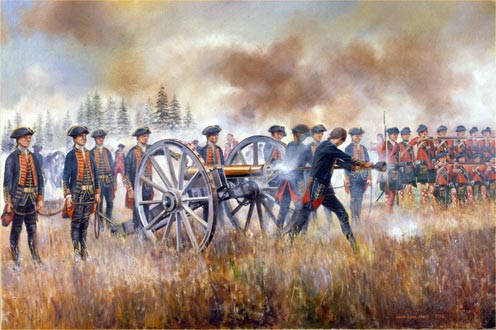
"Capt Macleod's Company, 1st Battalion Royal Artillery at the Battle of Quebec"
Ref: DR004
by David Rowlands
Image Size 58 x 38 cm
13 September 1759: The objective of the 1759 campaign in Canada was the capture of the city of Quebec from the French. The city stands on high ground beside the St Lawrence River and was strongly fortified. Major General James Wolfe commanded the British force. The French were confident that the steep cliffs and the apparent lack of any suitable landing places would prevent the British from coming ashore on that side of Quebec. But General Wolfe had spotted a steep, narrow zig-zag path that led to the top of the cliffs. Under cover of darkness the British troops scaled the path and during the morning were drawn up in a single line of battalions facing the city. A single 6-pounder gun, of a type specially prepared for service in Canada, supported them. Another gun was manhandled with great difficulty up the narrow path but it seems not to have been in position, when the French army marched forward to engage them.
The French and Indian skirmishers caused a number of casualties among the British infantry, who were lying down. The British artillerymen were standing, firing their one gun against the three guns which were supporting the French attack. When the redcoats rose up and stood quietly in their long line, the advancing French infantry opened fire at 200 yards, too great a range for those days. Waiting confidently, the British let the enemy approach to 35 yards, when their muskets opened a crashing volley. With bayonets fixed, they advanced through the thick clouds of smoke, and the French were routed. Quebec was surrendered.
Malcolm Fraser, a lieutenant in the 78th Highlanders, wrote, 'Before eleven o'clock we got one brass field piece up the Hill, which being placed in its proper interval begun to play very smartly on the Enemy while forming…' It was placed between the 78th Highlanders and the 47th Foot. The gun detachment is shown reloading after a shot has been fired. The spongeman is swabbing out the bore to extinguish any smouldering particles left from the previous cartridge. A gun number hands a cartridge to the loader, who will place it in the muzzle. Three artillerymen stand at each side, facing the enemy, holding the drag ropes in their hands. Each time the gun fired, it would recoil several yards, and these men would fall back with it, connect the drag ropes to the wheels, and haul the gun back to its position. The reason for posting the men in this manner was to prevent the enemy's shot doing the execution it would, were three or four men to stand behind one another. Instructions throughout the eighteenth century laid great stress upon the safety factor, and frequently ordered ammunition boxes to be removed from the guns and placed in the rear.
